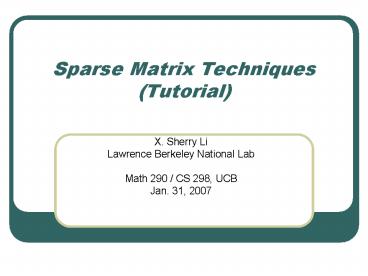Sparse Matrix Techniques (Tutorial) - PowerPoint PPT Presentation
1 / 18
Title:
Sparse Matrix Techniques (Tutorial)
Description:
Computer representations of sparse matrices. Sparse matrix-vector ... 'triplets' format ({i, j, val}) is not sufficient . . . Storage: 2*NNZ integers, NNZ reals ... – PowerPoint PPT presentation
Number of Views:569
Avg rating:3.0/5.0
Title: Sparse Matrix Techniques (Tutorial)
1
Sparse Matrix Techniques(Tutorial)
- X. Sherry Li
- Lawrence Berkeley National Lab
- Math 290 / CS 298, UCB
- Jan. 31, 2007
2
Outline
- Part I
- Computer representations of sparse matrices
- Sparse matrix-vector multiply with various
storages - Performance optimizations
- Part II
- Techniques for sparse factorizations
- (e.g., SuperLU solver)
3
Sparse Storage Schemes
- Notation
- N dimension
- NNZ number of nonzeros
- Assume arbitrary sparsity pattern
- triplets format (i, j, val) is not sufficient
. . . - Storage 2NNZ integers, NNZ reals
- Not easy to randomly access one row or column
- Linked list format provides flexibility, but not
friendly on modern architectures . . . - Cannot call BLAS directly
4
Compressed Row Storage (CRS)
- Store nonzeros row by row contiguously
- Example N 7, NNZ 19
- 3 arrays
- Storage NNZ reals, NNZN1 integers
5
SpMV (y Ax) with CRS
- dot product
- No locality for x
- Vector length usually short
- Memory-bound 3 reads, 2 flops
6
Compressed Column Storage (CCS)
- Also known as Harwell-Boeing format
- Store nonzeros columnwise contiguously
- 3 arrays
- Storage NNZ reals, NNZN1 integers
7
SpMV (y Ax) with CCS
- SAXPY
- No locality for y
- Vector length usually short
- Memory-bound 3 reads, 1 write, 2 flops
y(i) 0.0, i 1N do j 1, N . . .
column j of A t x(j) do i colptr(j),
colptr(j1) 1 y(rowind(i))
y(rowind(i)) nzval(i) t enddo enddo
8
Jagged Diagonal Storage (JDS)
- Also known as ITPACK, or Ellpack storage Saad,
Kincaid et al. - Force all rows to have the same length as the
longest row, - then columns are stored contiguously
- 2 arrays nzval(N,L) and colind(N,L), where L
max row length - NL reals, NL integers
- Usually L ltlt N
9
SpMV with JDS
- Neither dot nor SAXPY
- Good for vector processor long vector length (N)
- Extra memory, flops for padded zeros, especially
bad if row lengths vary a lot
y(i) 0.0, i 1N do j 1, L do i 1, N
y(i) y(i) nzval(i, j) x(colind(i,
j)) enddo enddo
10
Segmented-Sum Blelloch et al.
- Data structure is an augmented form of CRS
- Computational structure is similar to JDS
- Each row is treated as a segment in a long vector
- Underlined elements denote the beginning of each
segment - (i.e., a row in A)
- Dimension S L NNZ, where L is chosen to
approximate the hardware vector length
11
SpMV with Segmented-Sum
- 2 arrays nzval(S, L) and colind(S, L), where SL
NNZ - NNZ reals, NNZ integers
- Good for vector processors
- SpMV is performed bottom-up, with each row-sum
(dot) of Ax stored in the beginning of each
segment - Similar to JDS, but with more control logic in
inner-loop
do i S, 1 do j 1, L . . .
enddo enddo
12
Performance (megaflop rate) Gaeke et al.
- Test matrix N 10000, NNZ 177782, random
pattern - 18 nonzeros per row on average
- JDS does 4.6x more operations
machine Ultra 2i Pentium 4 VIRAM
Clock rate 333 MHz 1.5 GHz 200 MHz
Peak flop rate 667 Mflops 1.5 Gflops 1.6 Gflops
CRS 29 209 110
JDS (effective) 27 6 17 4 632 137
Seg-Sum 5 29 165
13
Optimization Techniques
- Matrix reordering
- For CRS SpMV, can improve x-vector locality by
reducing the bandwidth of matrix A - Example reverse Cuthill-McKee (breadth-first
search) - Observed 2-3x improvement Toledo, et al.
14
Optimization Techniques
- Register blocking
- Find dense blocks of size r-by-c in A
- (If needed, allow some zeros to be filled in)
- Ax is proceeded block by block
- keep c elements of x and r elements of y in
registers - x element re-used r times, y element re-used c
times - Amount of indexed load and store is reduced
- Obtained up to 2.5x improvement Vuduc et al.
15
SPARSITY Im, Yelick
16
Performance Improvement Vuduc et al.
17
Other Representations
- Block entry formats (e.g., multiple degrees of
freedom are associated with a single physical
location) - Constant block size (BCRS)
- Varying block sizes (VBCRS)
- Skyline (or profile) storage (SKS)
- Lower triangle stored row by row
- Upper triangle stored column by column
- In each row (column), first nonzero
- defines a profile
- All entries within the profile
- (some may be zeros) are stored
18
References
- Templates for the solution of linear systems
- Barrett, et al., SIAM, 1994
- BeBOP http//bebop.cs.berkeley.edu/
- Sparse BLAS standard
- http//www.netlib.org/blas/blast-forum

